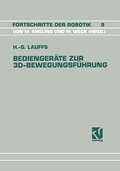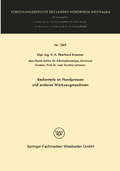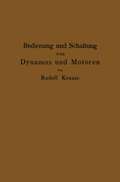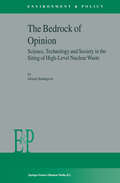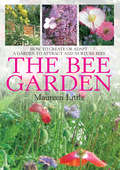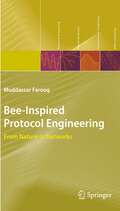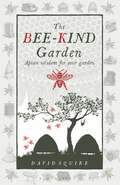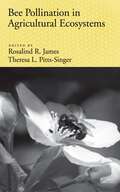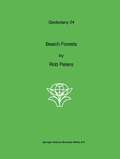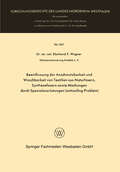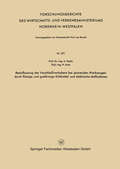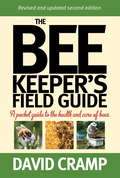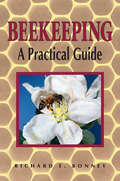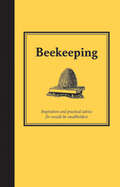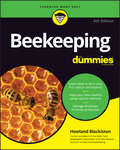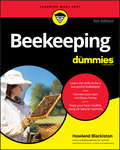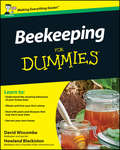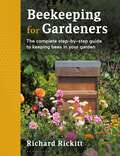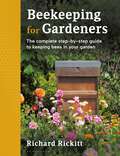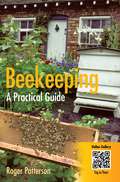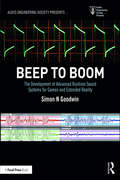- Table View
- List View
Bediengeräte zur 3D-Bewegungsführung: Ein Beitrag zur effizienten Roboterprogrammierung (Fortschritte der Robotik #9)
by Hans-Georg LauffsBedienteile an Handpressen und anderen Werkzeugmaschinen (Forschungsberichte des Landes Nordrhein-Westfalen #1269)
by Henning WodeÜber die zweckmäßige Art und günstige räumliche Anordnung von Bedienteilen - wie Handräder, Kurbeln und Hebel-gibt es eine umfangreiche Literatur. Sie ist jedoch fast ausnahmslos beschränkt auf folgende Anwendungsfälle : 1. a) Einstellen eines mit dem Bedienteil gekoppelten Zeigers auf eine gewünschte Lage. b) Nachfahren einer sich bewegenden Marke mit einem Zeiger, der mit dem Bedienteil gekoppelt ist. c) Fälle a) und b) jeweils bei einer Teil- oder vollen Umdrehung oder bei meh reren Umdrehungen des Bedienteils ; bei unterschiedlichen Drehwider ständen. 2. a) Einleitung eines möglichst großen Energiebetrages in das Bedienteil bei einer Umdrehung oder mehreren aufeinanderfolgenden Umdrehungen des Bedienteiles. b) Einleiten eines möglichst großen statischen Drehmomentes oder einer mög lichst großen Kraft in das ganz oder nahezu feststehende Bedienteil. Anscheinend fehlen aber noch Untersuchungen über die zweckmäßige Art und Lage von Bedienteilen, an denen vom Menschen Arbeit geleistet werden soll, in 0 dem er sie um weniger als 360 wiederholt gegen einen Arbeitswiderstand hin bewegt und unbelastet zurückbewegt. Da solche Arbeitsbedingungen in der Praxis häufig vorkommen - wie u. a. in diesem Bericht nachgewiesen wird -, ist eine Untersuchung hierüber angebracht. Um Klarheit für den folgenden Bericht zu schaffen, müssen zunächst einige De finitionen gegeben werden: »Handpresse« ist eine Presse, deren für den Arbeitsvorgang notwendige Energie vom Menschen über seine Hand in sie eingeleitet wird. Die Energiezufuhr durch den Menschen erfolgt über das »Bedienteil« : »Bedienteil« ist das Bauteil, über das ein Mensch auf eine Vorrichtung die für die Arbeitsaufgabe nötige Energie überträgt.
Bedienung und Schaltung von Dynamos und Motoren sowie für kleine Anlagen ohne und mit Akkumulatoren
by Rudolf KrauseThe Bedrock of Opinion: Science, Technology and Society in the Siting of High-Level Nuclear Waste (Environment & Policy #32)
by G. SundqvistWhen did man discover nuclear waste? To answer this question, we first have to ask if nuclear waste really is something that could be called a scientific discovery, such as might deserve a Nobel Prize in physics. In early writings within nuclear energy research radioactive waste appears to be a neglected issue, a story never told. Nuclear waste first seems to appear when a public debate arose about public health risks of nuclear power in the late 1960s and early 70s. In nuclear physics, consensus was established at an early stage about the understanding of the splitting of uranium nuclei. The fission products were identified and their chains of disintegration and radioactivity soon were well established facts among the involved scientists, as was an awareness of the risks, for example the strong radioactivity of strontium and iodine, and the poisonous effects of plutonium. However, the by-products were never, either in part or in total, called or perceived as waste, just as fission by-products. How and where to dispose of the by-products were questions that were never asked by the pioneers of nuclear physics.
The Bee Garden: How to Create or Adapt a Garden to Attract and Nurture Bees
by Maureen LittleBees play a vital and irreplaceable role in pollinating our flowers, fruits and vegetables. The more bees in your garden the healthier, more productive and more pleasant a place it will be. Yet bees are declining rapidly and many people, even if they do not wish to keep bees themselves, are asking what can be done on an individual basis to help the bee. This book is a response to that request. It will demonstrate in one accessible volume how each of us can play our part in providing a bee-friendly environment, no matter how much gardening space and/or time we may have. It includes: * How bees forage, what bees you can expect to find in your garden and what plants are best for them. * Why honey bees are so important; what they need to thrive and how they detect and access those requirements; and what varieties of plants are best suited to provide those needs. * How the gardener can offer and maintain a bee-friendly garden, followed by a season-by-season account of what beefriendly plants are in flower and when, and what jobs the gardener can be doing during these times to help bees thrive. * A gazetteer of selected bee-friendly plants, arranged by type of plant in seasonal sub-sections. * Illustrative, practical planting plans, including a culinary herb garden, a potager, a wild flower garden, and a 3 seasons traditional border.
Bee-Inspired Protocol Engineering: From Nature to Networks (Natural Computing Series)
by Muddassar FarooqHoney bee colonies demonstrate robust adaptive efficient agent-based communications and task allocations without centralized controls – desirable features in network design. This book introduces a multipath routing algorithm for packet-switched telecommunication networks based on techniques observed in bee colonies. The algorithm, BeeHive, is dynamic, simple, efficient, robust and flexible, and it represents an important step towards intelligent networks that optimally manage resources. The author guides the reader in a survey of nature-inspired routing protocols and communication techniques observed in insect colonies. He then offers the design of a scalable framework for nature-inspired routing algorithms, and he examines a practical application using real networks of Linux routers. He also utilizes formal techniques to analytically model the performance of nature-inspired routing algorithms. In the last chapters of the book, he introduces an immune-inspired security framework for nature-inspired algorithms, and uses the wisdom of the hive for routing in ad hoc and sensor networks. Finally, the author provides a comprehensive bibliography to serve as a reference for nature-inspired solutions to networking problems. This book bridges the gap between natural computing and computer networking. What sets this book apart from other texts on this subject is its natural engineering approach in which the challenges and objectives of a real-world system are identified before its solution, nature-inspired or otherwise, is discussed. This balanced exposition of the book makes it equally suitable for telecommunication network designers and theorists, and computer science researchers engaged with artificial intelligence, agents, and nature-inspired techniques.
The Bee-Kind Garden: Apian wisdom for your garden (Wise Words #1)
by David SquireThe lives of bees are interwoven with our own, but how much do you know about them?Which scents do bees prefer? How do bees transport pollen? How far can bees fly? Do specific colours attract bees? Do bees prefer native flowers? Bees are a delight to see in the garden on warm summer days, buzzing as they flit from flower to flower. They are also vital for the future of the planet and without their dedicated pollinating skills, many crops would eventually fail. Then there is honey – a near-miraculous elixir that in earlier generations was an integral part of life as a sweetener and food preserver. It can be fermented with water and yeast to create mead, a drink that has been enjoyed for thousands of years. The Bee-Kind Garden reveals the many facets of the lives of bees, including their hives, flight patterns and defence. It is filled with helpful information on important topics such as which flowers are best for attracting bees to your garden, beekeeping equipment and guidance for extracting honey as well as the art of talking to bees. It also celebrates the charming proverbs, limericks and verse bees have inspired.This delightfully illustrated book is a homage to bees and to ensuring that they continue to live in harmony with humans in bee-friendly gardens.
Bee Pollination in Agricultural Ecosystems
by Rosalind James Theresa L. Pitts-SingerFor many agricultural crops, bees play a vital role as pollinators, and this book discusses the interplay among bees, agriculture, and the environment. Although honey bees are well recognized as pollinators, managed bumble bees and solitary bees are also critical for the successful pollination of certain crops, while wild bees provide a free service. As bees liberally pass pollen from one plant to the next, they also impact the broader ecosystem, and not always to the benefit of humankind. Bees can enhance the unintentional spread of genes from genetically engineered plants, and may increase the spread of invasive weeds. Conversely, genetically engineered plants can impact pollinators, and invasive weeds can supply new sources of food for these insects. Bees' flower-visiting activities also can be exploited to help spread biological control agents that control crop pests, and they are important for native plant reproduction. Managing bees for pollination is complex and the factors that must be taken into consideration are treated here, including bee natural history, physiology, pathology, and behavior. Furthermore, transporting bees from native ranges to new areas for pollination services can be controversial, and needs to be done only after assuring that it will not disrupt various ecosystems. Even though bees are small, unobtrusive creatures, they play large roles in the ecosystem. The connection between bees and humankind also is symbolic of a broader interconnection between humans and the natural world.
Bee Pollination in Agricultural Ecosystems
by Rosalind R. James Theresa L. Pitts-SingerFor many agricultural crops, bees play a vital role as pollinators, and this book discusses the interplay among bees, agriculture, and the environment. Although honey bees are well recognized as pollinators, managed bumble bees and solitary bees are also critical for the successful pollination of certain crops, while wild bees provide a free service. As bees liberally pass pollen from one plant to the next, they also impact the broader ecosystem, and not always to the benefit of humankind. Bees can enhance the unintentional spread of genes from genetically engineered plants, and may increase the spread of invasive weeds. Conversely, genetically engineered plants can impact pollinators, and invasive weeds can supply new sources of food for these insects. Bees' flower-visiting activities also can be exploited to help spread biological control agents that control crop pests, and they are important for native plant reproduction. Managing bees for pollination is complex and the factors that must be taken into consideration are treated here, including bee natural history, physiology, pathology, and behavior. Furthermore, transporting bees from native ranges to new areas for pollination services can be controversial, and needs to be done only after assuring that it will not disrupt various ecosystems. Even though bees are small, unobtrusive creatures, they play large roles in the ecosystem. The connection between bees and humankind also is symbolic of a broader interconnection between humans and the natural world.
Beeinflussung der Anschmutzbarkeit und Waschbarkeit von Textilien aus Naturfasern, Synthesefasern sowie Mischungen durch Spezialausrüstungen (Forschungsberichte des Landes Nordrhein-Westfalen #1411)
by Eberhard Frithjof WagnerBeeinflussung des Verschleißverhaltens bei spanenden Werkzeugen durch flüssige und gasförmige Kühlmittel und elektrische Maßnahmen (Forschungsberichte des Wirtschafts- und Verkehrsministeriums Nordrhein-Westfalen #271)
by Herwart OpitzThe Beekeeper's Field Guide: A Pocket Guide to the Health and Care of Bees
by David CrampThis guide is a diagnostic tool and an aide memoire for the hobbyist and for the professional beekeeper, who may know what to do but will at times need the information close to hand. It includes: - A troubleshooting guide to problems with colonies and queen bees - A guide to the field diagnosis, treatment and control of diseases - Seasonal apiary management checklists - Hive product harvesting checklists - The beekeeper's ready reckoner The second and revised edition of this fully illustrated and handy guide to the apiary brings the science and craft of beekeeping to beekeepers right where they need it - in the field with the bees.Contents: Preface; List of figures; List of photographs; List of tables; Picture credits; Introduction; Part A: Setting up an Apiary; Part B: Crops, Trees and Plants for Bees; Part C: Troubleshooting Guide to Field Operations; Part D: Swarm Prevention and Control; Part E: Queen Bees; Part F: Honey Harvest Procedures; Part G: Hive Checks; Part H: Pests and Diseases; Part I: A Beekeeper's Ready-reckoner; Part J.
Beekeeping: A Practical Guide
by Richard E. BonneyKeep your own bees and enjoy delicious golden honey from your own backyard. With his respect and admiration for bees evident on every page, Richard E. Bonney describes how to acquire bees, manage a hive, prevent and treat diseases, and extract a crop of honey. Enthusiastic beekeepers of every stripe and experience level will benefit from Bonney&’s astonishing knowledge of the craft — from beekeeping history and honeybee biology to the complex social structure of the hive.
Beekeeping: Inspiration And Practical Advice For Would-be Smallholders (Countryside Ser.)
by Andrew T. DaviesIt's no shock that the beekeeping trend is steadily on the rise. These fascinating and beautiful insects can be kept anywhere, whether your garden is a large country plot or an urban rooftop terrace. What's more, there's no sting in this tale: bees are a source of delight for honey lovers, hay-fever sufferers and gardeners alike.
Beekeeping For Dummies
by Howland BlackistonEverything you need to 'bee' a successful backyard beekeeper If you've ever thought about becoming a backyard beekeeper—or have already tried a hand at it and want to be better one—then this is the book for you! In Beekeeping for Dummies, 4th Edition you'll find everything you need to know in order to start your own colony, including how to assemble and maintain beehives, handle every phase of honey production, purchase and use all the latest tools, and what to do beyond your first season. This hands-on guide provides all the tools, tips, tricks, and techniques needed to become a real backyard beekeeper. You'll learn to identify the queen from her workers and drones, properly open and close the hive, distinguish one type of honey from another, and preserve your colony if disaster should strike. Keep bees on a small urban rooftop or in a large country yard Assemble your own hive and sustain it for years to come Safely inspect and manage your colony Harvest and sell your own honey Becoming a backyard beekeeper isn't as hard as people think—and with this hands-on guide, you'll be able to create one honey of a colony that will have the neighbors buzzing.
Beekeeping For Dummies
by Howland BlackistonEverything you need to 'bee' a successful backyard beekeeper If you've ever thought about becoming a backyard beekeeper—or have already tried a hand at it and want to be better one—then this is the book for you! In Beekeeping for Dummies, 4th Edition you'll find everything you need to know in order to start your own colony, including how to assemble and maintain beehives, handle every phase of honey production, purchase and use all the latest tools, and what to do beyond your first season. This hands-on guide provides all the tools, tips, tricks, and techniques needed to become a real backyard beekeeper. You'll learn to identify the queen from her workers and drones, properly open and close the hive, distinguish one type of honey from another, and preserve your colony if disaster should strike. Keep bees on a small urban rooftop or in a large country yard Assemble your own hive and sustain it for years to come Safely inspect and manage your colony Harvest and sell your own honey Becoming a backyard beekeeper isn't as hard as people think—and with this hands-on guide, you'll be able to create one honey of a colony that will have the neighbors buzzing.
Beekeeping For Dummies: 4th Edition
by Howland BlackistonThe single best and most comprehensive guide for prospective, new and experienced hobbyist beekeepers Beekeeping For Dummies, 5th Edition, is one of the most popular titles in the For Dummies series available today. Including the latest information regarding every aspect of backyard beekeeping and honey production, this book describes how to get started, how to care for and safely handle bees, and how to maintain healthy and productive colonies. This book is loaded with up-to-date, practical examples and helpful illustrations of proven techniques and strategies for both new and seasoned hobbyist beekeepers. Some of the updates for this brand-new edition include: New information regarding the critical role that nutrition plays in the health and productivity of your bees News about the latest beekeeping products, medications, and all-natural remedies Information regarding dozens of helpful beekeeping resources Redeemable coupons from beekeeping suppliers that save the reader money Beekeeping For Dummies embodies the straightforward and simple approach made famous by the For Dummies series. Each and every reader will benefit from its accessible and approachable take on beekeeping.
Beekeeping For Dummies
by Howland BlackistonThe single best and most comprehensive guide for prospective, new and experienced hobbyist beekeepers Beekeeping For Dummies, 5th Edition, is one of the most popular titles in the For Dummies series available today. Including the latest information regarding every aspect of backyard beekeeping and honey production, this book describes how to get started, how to care for and safely handle bees, and how to maintain healthy and productive colonies. This book is loaded with up-to-date, practical examples and helpful illustrations of proven techniques and strategies for both new and seasoned hobbyist beekeepers. Some of the updates for this brand-new edition include: New information regarding the critical role that nutrition plays in the health and productivity of your bees News about the latest beekeeping products, medications, and all-natural remedies Information regarding dozens of helpful beekeeping resources Redeemable coupons from beekeeping suppliers that save the reader money Beekeeping For Dummies embodies the straightforward and simple approach made famous by the For Dummies series. Each and every reader will benefit from its accessible and approachable take on beekeeping.
Beekeeping For Dummies: 4th Edition
by David Wiscombe Howland BlackistonThe fast and easy way to start and maintain a hive Beekeeping For Dummies is a practical, step-by-step beginner's guide to beekeeping. It gives you plain-English guidance on everything you need to know to start your own beehive, from buying the right equipment, sourcing bees, and locating your hive to maintaining a healthy colony and harvesting honey. Plus, you'll get the latest information on the causes and effects of bee disease, colony collapse disorder, and the impact the sudden disappearance of the honeybee has on our environment and economy. Here, you'll get trusted information on beekeeping in the UK, specifically written to address climate, buying equipment, locating hives, the local impact of colony collapse disorder and ways to avoid or minimise the risk to your hive, seasonal beekeeping tasks, local beekeeping associations, and updated content on urban beekeeping. Understand the anatomy of your bees Learn techniques and tips for harvesting, bottling, packaging, and selling honey Discover the benefits of beekeeping Learn techniques on obtaining and hiving your bees If you're a beginner beekeeper, taking a beekeeping course, or just have an interest in the plight of the honeybee, Beekeeping For Dummies has you covered!
Beekeeping For Dummies
by David Wiscombe Howland BlackistonThe fast and easy way to start and maintain a hive Beekeeping For Dummies is a practical, step-by-step beginner's guide to beekeeping. It gives you plain-English guidance on everything you need to know to start your own beehive, from buying the right equipment, sourcing bees, and locating your hive to maintaining a healthy colony and harvesting honey. Plus, you'll get the latest information on the causes and effects of bee disease, colony collapse disorder, and the impact the sudden disappearance of the honeybee has on our environment and economy. Here, you'll get trusted information on beekeeping in the UK, specifically written to address climate, buying equipment, locating hives, the local impact of colony collapse disorder and ways to avoid or minimise the risk to your hive, seasonal beekeeping tasks, local beekeeping associations, and updated content on urban beekeeping. Understand the anatomy of your bees Learn techniques and tips for harvesting, bottling, packaging, and selling honey Discover the benefits of beekeeping Learn techniques on obtaining and hiving your bees If you're a beginner beekeeper, taking a beekeeping course, or just have an interest in the plight of the honeybee, Beekeeping For Dummies has you covered!
Beekeeping for Gardeners: The complete step-by-step guide to keeping bees in your garden
by Richard RickittA comprehensive gardener's guide to sustainable beekeeping.Beekeeping has changed. While once it was a hobby that pursued the rich rewards of honey and wax, many new beekeepers now instead seek the gratification of knowing that they are aiding the survival of one of the world's most important creatures. Keeping bees today is as much about providing the right habitats and resources to help pollinators thrive as it is about chasing every drop of golden honey.This beautifully illustrated guide to the ancient hobby of beekeeping shows today's gardeners how to create beautiful gardens that are richly rewarding for people and bees alike. Flowers, shrubs, trees and vegetable plots can provide colourful beauty and delicious produce as well as vital pollen and nectar when bees need it the most. There are lists of the top-performing plants and how and where to grow them, including window boxes, lawns, borders, wild gardens and even ponds.Beekeeping for Gardeners looks at the pleasures and benefits of keeping honey bees in gardens of all types and sizes, both rural and urban. It explains the practicalities involved in keeping bees in the domestic garden setting, as well as on rooftops, allotments, parks, farmland and other locations. Importantly, and unlike any book before, this guide sets the delightful hobby of beekeeping within the context of the wider environment, asking how it can best serve the needs of all types of pollinator and the local ecology in general.Whether you're looking to attract more bumblebees and solitary bees or want to install a beehive, this wonderful book contains all the guidance you'll need to have a garden buzzing with bees.
Beekeeping for Gardeners: The complete step-by-step guide to keeping bees in your garden
by Richard RickittA comprehensive gardener's guide to sustainable beekeeping.Beekeeping has changed. While once it was a hobby that pursued the rich rewards of honey and wax, many new beekeepers now instead seek the gratification of knowing that they are aiding the survival of one of the world's most important creatures. Keeping bees today is as much about providing the right habitats and resources to help pollinators thrive as it is about chasing every drop of golden honey.This beautifully illustrated guide to the ancient hobby of beekeeping shows today's gardeners how to create beautiful gardens that are richly rewarding for people and bees alike. Flowers, shrubs, trees and vegetable plots can provide colourful beauty and delicious produce as well as vital pollen and nectar when bees need it the most. There are lists of the top-performing plants and how and where to grow them, including window boxes, lawns, borders, wild gardens and even ponds.Beekeeping for Gardeners looks at the pleasures and benefits of keeping honey bees in gardens of all types and sizes, both rural and urban. It explains the practicalities involved in keeping bees in the domestic garden setting, as well as on rooftops, allotments, parks, farmland and other locations. Importantly, and unlike any book before, this guide sets the delightful hobby of beekeeping within the context of the wider environment, asking how it can best serve the needs of all types of pollinator and the local ecology in general.Whether you're looking to attract more bumblebees and solitary bees or want to install a beehive, this wonderful book contains all the guidance you'll need to have a garden buzzing with bees.
Beekeeping - A Practical Guide: A Practical Guide
by Roger PattersonA practical book for new beekeepers and those interested in keeping their own bees, explaining everything they need to know to get started. It also covers how to make your garden attractive for bees. Published to coincide with the biggest beginners' day for beekeeping which takes place in February each year.
Beep to Boom: The Development of Advanced Runtime Sound Systems for Games and Extended Reality (Audio Engineering Society Presents)
by Simon N GoodwinDrawing on decades of experience, Beep to Boom: The Development of Advanced Runtime Sound Systems for Games and Extended Reality is a rigorous, comprehensive guide to interactive audio runtime systems. Packed with practical examples and insights, the book explains each component of these complex geometries of sound. Using practical, lowest-common-denominator techniques, Goodwin covers soundfield creation across a range of platforms from phones to VR gaming consoles. Whether creating an audio system from scratch or building on existing frameworks, the book also explains costs, benefits and priorities. In the dynamic simulated world of games and extended reality, interactive audio can now consider every intricacy of real-world sound. This book explains how and why to tame it enjoyably.
